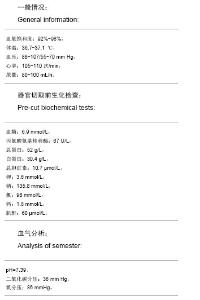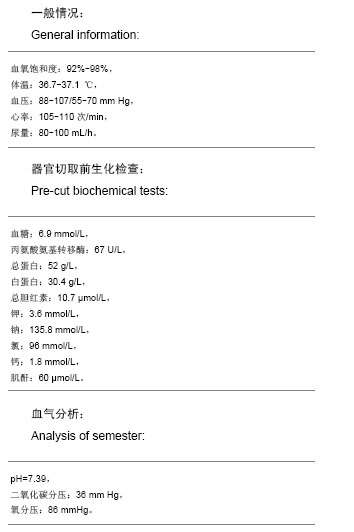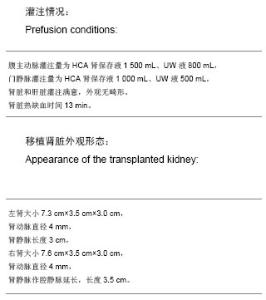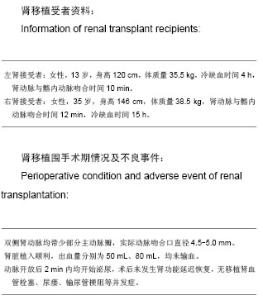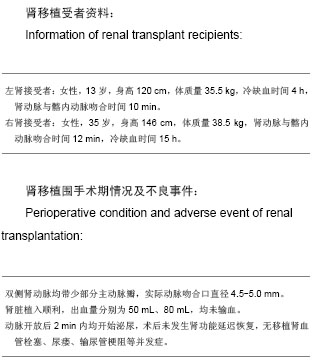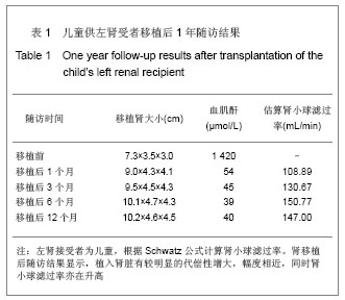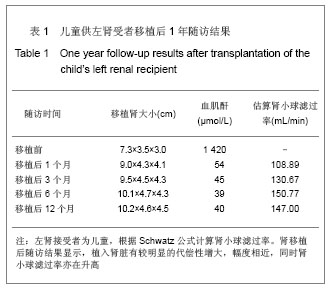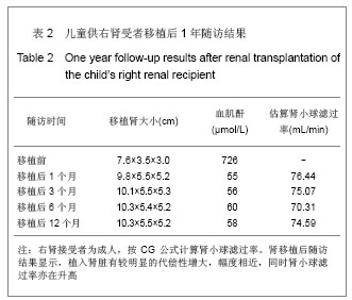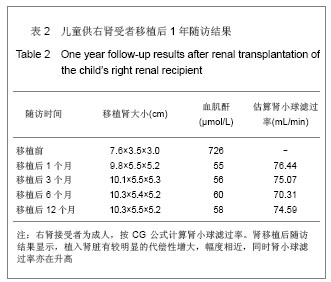| [1] Organ Transplantation Society of Chinese Medical Association. Zhonghua Qiguan Yizhi Zazhi. 2011;32(12): 756-758.中华医学会器官移植学分会. 中国心脏死亡器官捐献工作指南(第2版)[J]. 中华器官移植杂志,2011,32(12):756-758. [2] The Drafting Committee for Diagnostic Criteria of Brain Death of the Ministry of Health. Zhonghua Yixue Zazhi. 2003;83(3):262.卫生部脑死亡判定标准起草小组.脑死亡判定标准(成人)(征求意见稿) [J].中华医学杂志,2003,83(3):262.[3] The Drafting Committee for Diagnostic Criteria of Brain Death of the Ministry of Health. Zhonghua Yixue Zazhi. 2003;83(3):264.卫生部脑死亡判定标准起草小组. 脑死亡判定技术规范(征求意见稿) [J].中华医学杂志,2003,83(3): 264.[4] Mattman A, Eintracht S, Mock T, et al.Estimating pediatric glomerular filtration rates in the era of chronic kidney disease staging. J Am Soc Nephrol. 2006;17:487-496.[5] Pan RR, Ye JJ, Yang L, et al. Jiangsu Daxue Xuebao: Yixueban. 2011;21(9):409-412.潘瑞蓉, 叶菁菁, 杨玲, 等. 肾小球滤过率评估公式的适用性分析[J]. 江苏大学学报: 医学版, 2011,21(9):409-412.[6] Chen ZH, Zhang SM, Lei T, et al. Zhonghua Yixue Zazhi. 2004;84(8):619-621.陈忠华,张苏明,雷霆,等. 我国首例儿童脑死亡判定暨无偿器官捐献与移植[J].中华医学杂志,2004,84(8):619-621.[7] De Vries EE, Snoeijs MG, Van Heurn E. Kidney donation from children after cardiac death. Crit Care Med. 2010;38(1): 249-253.[8] Sung RS. Pedtatric kidney donation after caediac death. Nature Rew. 2010;6:387-388.[9] Xu L, Cai M, Li ZL, et al. Zhongguo Zuzhi Gongcheng Yanjiu yu Linchuang Kangfu, 2011;14(5):899-902.许亮, 蔡明, 李州利, 等. 脑死亡无偿器官捐献肾移植6例[J]. 中国组织工程研究与临床康复,2010,14(5):899-902.[10] Reicha DJ, Mulliganb DC, Abtc PL, et al. ASTS recommended practice guidelines for controlled donation after cardiac death organc procurement and transplantation. Am J Transplant. 2009;9:2004-2011.[11] Qian SY, Fan XM. Zhonghua Erke Zazhi. 2000;38(6):397-398.钱素云,樊寻梅.小儿脑死亡的临床表现和诊断[J]. 中华儿科杂志, 2000,38(6):397-398.[12] Fan XM. Beijing:Beijing Publishing House (Group). 1993: 462.樊寻梅. 实用儿科急诊学[M]. 北京: 北京出版社, 1993: 462.[13] Wang Y,Lu ZJ,Zhang LE.Xiaoer Jijiu Yixue Zazhi. 1996;3(1):32-33.王艺,陆铸今,张灵恩. 小儿脑死亡的诊断及其进展[J].小儿急救医学杂志,1996,3(1):32-33.[14] Lynch J, Eldadah MK. Brain death criteria currently used by pediatric intensivists. Clin Pediatr(Phila). 1992;31:457-460.[15] Jochmans I, Pirenne J. Graft quality assessment in kidney transplantation: not an exact science yet. Curr Opin Organ Transplant. 2011;16:174-179.[16] Sanchez-Fructuoso AI, Prats D, Torrente J, et al. Renal transplantation from non-heart beating donors: A promising alternative to enlarge the donor pool. J Am Soc Nephrol. 2000;11:350-358.[17] Weber M, Dindo D, Demartines N, et al. Kidney transplantation from donors without a heartbeat. N Engl J Med. 2002;347:248-255.[18] Rostron AJ,Avlonitis VS,Cork DM,et al. Hemodynamic resuscitation with arginine vasopressin reduces lung injury after brain death in the transplant donor. Transplantation. 2008;85(4):597-606. [19] Chamorro C, Falcón JA, Michelena JC. Controversial points in organ donor management. Transplant Proc. 2009;41(8): 3473-475.[20] Ma JJ, Chen ZH, Cao RH, et al. Zhonghua Qiguan Yizhi Zazhi. 2012;33(3):145-148.马俊杰,陈忠华,曹荣华,等.医院内心脏死亡器官捐献的探索及亲属尸体供肾移植首例报告[J]. 中华器官移植杂志,2012,33(3): 145-148.[21] Meng YM, Liu SR, Wu G, et al. Zhonghua Qiguan Yizhi Zazhi. 2011;32(12):709-711.孟一曼,刘树荣,吴刚,等. 心脏死亡供者供肾移植14例报告[J]. 中华器官移植杂志,2011,32(12):709-711.[22] Yuan Q, Zhang L, Wang LM, et al. Zhonghua Miniao Waike Zazhi. 2010;31(4):253-256.袁清,张雷,王立明,等. 低龄心脏停跳供者单个肾脏成人移植11例[J]. 中华泌尿外科杂志, 2010,31(4):253-256.[23] Wu R, Cai QQ. Guoji Miniao Xitong Zazhi. 2012;32(2): 284-286.吴然,蔡倩倩. 心脏死亡捐献中的肾脏保护研究进展[J]. 国际泌尿系统杂志,2012,32(2):284-286.[24] Deng DC, Gong ZY, Feng CZ, et al. Qiguan Yizhi. 2012;3(4): 209-212.邓德成,龚朝阳,冯春在,等. 幼儿心脏死亡器官捐献单侧供肾成人肾移植的临床研究[J]. 器官移植,2012,3(4):209-212.[25] Han LZ, Liu ZZ, Li JX. Xiandai Miniao Waike Zazhi. 2012; 17(5): 459-462.韩利忠,刘致中,李建新. 心脏死亡供肾肾移植9例临床分析[J]. 现代泌尿外科杂志, 2012,17(5): 459-462. [26] Shao MJ, Ye QF, Ming YZ, et al. Zhongnan Daxue Xuebao: Yixueban. 2012;37(10):1045-1049.邵明杰,叶启发,明英姿,等. 心脏死亡供体的移植肾功能延迟恢复的危险因素分析[J]. 中南大学学报:医学版, 2012,37(10): 1045-1049.[27] Karcioglu O,Ayrik C,Erbil B. The brain-dead patient or a flower in the vase? Ihe emergency department approach to the preservation of the organ donor. Eur J Emerg Med. 2003;10:52-57.[28] Fugate JE, Stadtler M, Rabinstein AA, et al. Variability in Donation After Cardiac Death Protocols: A National Survey. Transplantation. 2011;91(4):386-389.[29] Huo F, Wang SP, Li P, et al. Zhongguo Puwai Jichu yu Linchuang Zazhi. 2012;19(5): 468-472.霍枫, 汪邵平, 李鹏, 等. 心脏死亡器官捐献获取流程探讨[J]. 中国普外基础与临床杂志,2012,19(5): 468-472. [30] Zhou ZG, Li C, Li L, et al. Zhonghua Qiguan Yizhi Zazhi. 2012;33(7):171-173.周志刚,李超,李立,等. 心脏死亡器官捐献工作程序报告一例[J]. 中华器官移植杂志, 2012,33(7):171-173.[31] Deng YL, Zhang WY, Zhang YM, et al. Zhonghua Qiguan Yizhi Zazhi. 2012;33(2):109-112.邓永林,张玮晔,张雅敏,等. 心脏死亡器官捐献单中心经验总结[J]. 中华器官移植杂志, 2012,33(2):109-112.[32] Li YW, Deng YL, Ye QF, et al. Yixue yu Zhexue. 2012;33(1): 30-32.李育玮,邓云龙,叶啟发,等. 心脏死亡器官捐献家属决定的影响因素及对策研究[J]. 医学与哲学,2012,33(1):30-32.[33] Wei L, Zhu ZJ, Dong C, et al. Zhongguo Puwai Jichu yu Linchuang Zazhi. 2012;19(5):490-492.魏林,朱志军,董冲,等. 儿童心脏死亡器官捐献供肝在成人受者肝移植中的应用(附1例报道) [J].中国普外基础与临床杂志, 2012,19(5):490-492.[34] Wei L, Chen ZS, Guo H, et al. Zhongguo Puwai Jichu yu Linchuang Zazhi. 2012;19(5):473-477.魏来,陈知水,郭辉,等. 10例心脏死亡器官捐献移植总结[J]. 中国普外基础与临床杂志,2012,19(5):473-477.[35] Shen ZY, Deng YL, Zhang WY, et al. Zhonghua Putong Waike Zazhi. 2010;25(9):781-782.沈中阳,邓永林,张玮晔,等. 国际肝移植学会第16届年会心脏死亡供体应用会议纪要[J]. 中华普通外科杂志,2010,25(9): 781-782.[36] Men HW, Cai JZ. Guoji Yizhi yu Xueye Jinghua Zazhi. 2011;9 (4):8-12.门贺伟,蔡金贞. 心脏死亡供肝热缺血-损伤的研究进展[J]. 国际移植与血液净化杂志,2011,9(4):8-12.[37] Li L. Zhongguo Puwai Jichu yu Linchuang Zazhi. 2012;19(5): 464-467.李立. 中国器官移植的现状与出路——心脏死亡器官捐献的标准与应用[J]. 中国普外基础与临床杂志, 2012,19(5):464-467.[38] Ming YZ, Ye QF, Shao MJ, et al. Zhongnan Daxue Xuebao: Yixueban. 2012;37(6):598-605.明英姿,叶启发,邵明杰,等. 心脏死亡供者肾移植48例临床分析[J]. 中南大学学报:医学版, 2012,37(6):598-605. |
